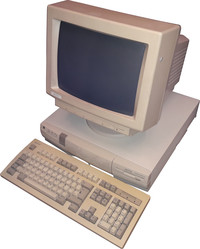Apricot XEN-PCm
| Home > Browse Our Collection > Computers > Apricot > Apricot XEN-PCm |
|
The Apricot XEN-PCm is a high-quality sound and graphics multimedia version of the XEN-PC released in 1995. It has a Soundblaster card and is a 486 machine. "High performance and versatility are two essential factors in the continuing success of the Apricot XEN-PC range. In this latest line-up, the super fast Intel Pentium processor has been incorporated to provide one of the fastest desktop systems available. Combined with the Apricot engineered system design, the incredible 120MHz Pentium processor sets the agenda for the range as a whole. Graphical user interfaces such as Windows, NT and OS/2 have settled as the norm for all tasks from word processing to video editing. This is why all XEN-PC models include industry-leading graphic acceleration coprocessors to provide the very best on-screen performance. All models use local bus technology to closely integrate the video circuitry. The entire range features the Cirrus Logic GD5434 with 1MB video RAM, except for the XEN-PC 590 and 5120 which have 2MB as standard. For those seeking the ultimate in system and graphic performance, the new Matrox MGA Impression Plus board, rated at over 40 million WinMarks using the new WinMarks benchmarking system - WinBench Vr4, is available as an optional extra. As software packages and the files that they create become ever-more space consuming, a selection of high capacity hard drives are matched to the expected requirements of each model. When your requirements change, so too will your XEN-PC. Expanding each model is straightforward and, most importantly, fully industry standard. Each model uses widely available SIMM memory modules, processor upgrades, storage devices and peripheral boards." Full Processor Range from Intel 486DX4-100 to Pentium-120MHz Manufacturer: Apricot Comment on This Page Other Systems Related To Apricot XEN-PCm:
This exhibit has a reference ID of CH51756. Please quote this reference ID in any communication with the Centre for Computing History. |
|























